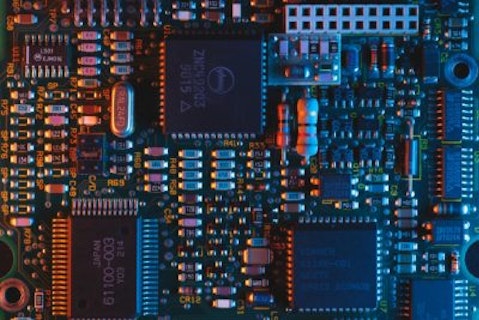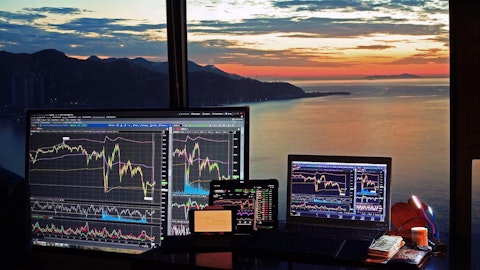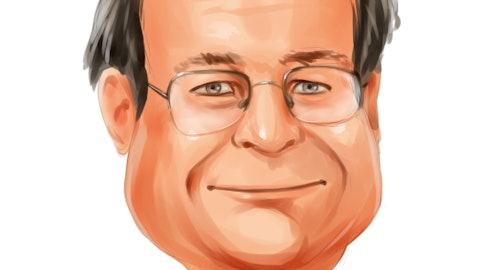Axcelis Technologies, Inc. (NASDAQ:ACLS) Q2 2023 Earnings Call Transcript August 3, 2023
Operator: Good day, ladies and gentlemen and welcome to the Axcelis Technologies call to discuss the company’s results for the Second Quarter. My name is Shannon McLead and I will be your coordinator for today. [Operator Instructions] I would now like to turn the presentation over to your host for today’s call, Doug Lawson, Executive Vice President of Corporate Marketing and Strategy. Please proceed.
Doug Lawson: Thank you, operator. This is Doug Lawson, Executive Vice President of Corporate Marketing and Strategy and with me today is Russell Low, President and CEO and Kevin Brewer, Executive Vice President and CFO. If you have not seen a copy of our press release issued yesterday, it is available on our website. Playback service will also be available on our website as described in our press release. Please note that comments made today about our expectations for future revenues, profits and other results are forward-looking statements under the SEC’s safe harbor provision. These forward-looking statements are based on management’s current expectations and are subject to the risk inherent in our business. These risks are described in detail in our Form 10-K annual report and other SEC filings, which we urge you to review.

Photo by Umberto on Unsplash
Our actual results may differ materially from our current expectations. We do not assume any obligation to update these forward-looking statements. Now, I’ll turn the call over to President and CEO, Russell Low.
Russell Low: Good morning and thank you for joining us for our second quarter 2023 earnings call. Demand for the Purion product family continues to be extremely strong, especially in the high-growth silicon carbide power segment. Revenue for the second quarter was $274 million, with earnings per share of $1.86. Backlog remained high at $1.2 billion with quarterly systems bookings of $193 million, also driven by Purion demand and strength in the power market. The third quarter of 2023, we expect revenue of approximately $280 million, gross margin of roughly 44%, operating profit of around $64 million and earnings per share of approximately $1.72. We are raising our forecasted 2023 revenue by $70 million to greater than $1.1 billion.
This represents year-over-year revenue growth of approximately 20% in a year in which overall WFE is expected to decrease by 20% to 30%. We also believe it’s possible to achieve $1.3 billion in revenue in the next 1 or 2 years depending on market conditions. The mature process technology market continues to be an area of strength for Axcelis, with 93% of second quarter system shipments going to mature foundry logic customers and 7% to memory customers, composed entirely of DRAM. The geographic mix of our system shipments in the second quarter was China 56%, the U.S. 13%, Korea 10%, Europe 9%, Taiwan 2%, Japan 2% and the rest of the world 8%. As has been the case since the beginning of this downturn, the power device segment and in particular, silicon carbide continues to drive our growth.
We are actively engaged with all our customers in this high-growth market segment, winning business from new customers and expanding our footprint in existing customers. We now expect approximately 60% of our shipped system revenue in 2023 to come from this segment, with around 35% of total shipped system revenue coming from silicon carbide applications. We’re seeing increased adoption of Purion H200 silicon carbide and Purion XE silicon carbide systems and now have 3 Purion H200 silicon carbide evaluations underway with customers in multiple geographies. Two of these systems are 150-millimeter and one is a 200-millimeter system. These evaluation units give our customers a head start qualifying productivity limiting recipes as they ramp to high volumes.
It also enables the customer to conduct optimization work on their devices utilizing the higher energy and dose capabilities of Purion H200 silicon carbide. In 2023, we expect revenue from silicon carbide customers to be spread relatively evenly across the Purion Power Series product family. Axcelis is the only iron implantation company that can deliver complete recipe coverage for all power device applications. We are considered to be the technology leader and the supplier of choice to provide the best product family and manufacturing capabilities. This means that using Axcelis tools provides the lowest risk path to high-volume manufacturing required to support aggressive fab ramp plans. Axcelis places significant value on enabling our customers to succeed in this exciting market by providing differentiated product performance and a high level of customer satisfaction.
As the industry downturn continues, we now estimate that memory will account for less than 10% of our shipped systems revenue and weighted towards DRAM. We expect the PC market will lead the industry out of this downturn beginning the second half of 2024 with 2025 returning to a healthy level of growth in consumer electronics, advanced logic and memory. While our memory and advanced logic customers are experiencing this downturn, Axcelis remains close to them, supporting their installed base and working with them on their future technology and manufacturing needs. It is during downturns there is an increased ability to collaborate with our customers to expand opportunities for Axcelis through the next upturn. We have multiple evaluation systems in these markets and many customer engagements designed to increase our footprint in these segments.
As the industry exits this downturn, [Technical Difficulty] return to healthy growth in these markets. This combined with continued strength in the Power segment will drive Axcelis have $1.3 billion model and beyond. Now I’d like to turn it over to Kevin.
Kevin Brewer: Thank you, Russell and good morning. We are pleased with our second quarter 2023 financial results and are excited about full-year revenue, which is now expected to exceed $1.1 billion and represents year-over-year growth of approximately 20%. Looking at our second quarter, revenue and earnings per share finished well above guidance due to solid execution and continued strong demand for Purion. Q2 revenue was $274 million with system revenue at $215.2 million and CS&I at $58.8 million. Q2 earnings per share of $1.86 was significantly above guidance due to higher-than-expected revenues, gross margin and favorable spending. We also benefited from much lower effective tax rate this quarter, driven by tax deduction associated with stock compensation.
Strong bookings and quoting activity for systems in the Power segment continued in the quarter, which supports our expectation that approximately 60% of systems revenue shipped will come from this market in 2023. CS&I revenue will fluctuate quarter-to-quarter, but should be modeled at approximately $248 million for 2023 and $300 million for our $1.3 billion revenue model. Q2 gross margin finished at 43.7% and 170 basis points above guidance, driven by lower costs in deferrals and a slightly improved mix. We expect Q3 gross margin to come in higher at approximately 44% and forecast further gross margin improvements in Q4. Key functions across the business remain laser focused on margin improvement. There are numerous initiatives underway to lower the cost of goods and drive higher sales of Purion product extensions, which allows us to model gross margin of approximately 45% in the $1.3 billion revenue model.
Turning to operating expenses. The second quarter ended at 20.4% of revenue and better than our guidance. We expect OpEx in the third quarter to be approximately 21%. As always, we will continue to tightly control spending, while investing in areas of the business that support business growth, solidify our technology advantage in the specialty markets and increase our footprint in the memory and advanced logic markets. Additionally, we will continue to invest in our employees and infrastructure required to achieve our financial models. One example of infrastructure investment is our new state-of-the-art logistics center in Beverley, Mass located just a short walk from our headquarters. The facility will open this month and is expected to be fully operational during Q4.
We also plan to further ramp our Beverly and Korean operations as capacity needs grow and are comfortable that we have initiatives in place that support our $1.3 billion revenue model. We ended Q2 with $452.9 million of cash, cash equivalents and short-term investments and generated $32.7 million of cash from operations. Cash in the quarter was impacted by higher inventory required to support the expected increase in second half revenue. In the quarter, we repurchased $12.5 million of stock and have returned over $157 million to capture shareholders since 2019 through our share repurchase programs. Axcelis has the rare opportunity to grow revenue and profitability during significant industry downturn. This is a result of strong product positioning in a power device market and continued strong execution in a challenging environment.
We also look forward to continued growth in memory and advanced logic as the overall semiconductor market recovers. Once again, I want to thank the entire Axcelis team for their continuing and outstanding performance. I also want to thank our supply chain partners for their hard work supporting Axcelis and our customers for their confidence in our ability to deliver. I will now turn the call back to Russell for his closing comments.
Russell Low: Thank you, Kevin. Axcelis expects to achieve revenue greater than $1.1 billion in 2023 and $1.3 billion over the next 1 or 2 years. This growth is achievable due to the following factors. First, the implant TAM has more than doubled in the last few years and are expected to grow between 10% and 15% annually with mature market segments representing greater than 60% of the total TAM. Second, Pat [indiscernible] and image sensors are highly implant intensive and the general mature nodes have increasing implant intensity peaking at 28-nanometers. Third, high-value Purion product extensions will be designed to optimize power and image sensor device manufacturing, making Axcelis the only company with a product line capable of covering all implant recipes in these key markets.
This uniquely positions Axcelis to benefit from high growth in the mature process technology markets. And finally, Axcelis’ strong long-term customer relationships and a fundamental cultural desire to win by making our customer successful. I want to thank our employees, suppliers, customers and investors for your continued support. With that, I’d like to open up for questions.
See also 15 Easiest Countries to Retire To and 25 Best Non-U.S. Universities and Colleges in the World.
Q&A Session
Follow Axcelis Technologies Inc (NASDAQ:ACLS)
Follow Axcelis Technologies Inc (NASDAQ:ACLS)
Operator: Thank you. [Operator Instructions] Our first question comes from Craig Ellis from B. Riley Securities.
Ethan Widell: This is Ethan Widell calling in for Craig Ellis. So the surge in margin was a nice surprise, does this impact your confidence in hitting 44.5% by fourth quarter and 44% overall for the year?
Kevin Brewer: This is Kevin. It was a nice surprise in Q2 and part of it came from better costs as well as a little bit better mix and some of the deferrals. I think on the last call, we talked about the second half becoming much stronger than first half to get towards that full year target of about 44%. And we’re on that, we’re probably a little bit of the strength in Q2 took away from Q3 a little bit, but we still think Q3 is up from Q3, up from Q2. And then in Q4, I expect to see further improvement off of that Q3 number of approximately 44%. So yeah, so we’re still — we’re still anticipating being in that 44% range for the full year.
Ethan Widell: And then are using signs that the — I’ve been with memory strength that SK Hynix and [Technical Difficulty] Micron are driving higher Purion Dragon demand [indiscernible]?
Doug Lawson: And this is Doug. So you broke up a little bit, but I think you’re asking about the high-bandwidth memory. So for implant, the implant content is similar for any of the DRAM, whether it’s HBM or other types. So what we see as far as sort of the goodness of the HBM ramp is, it starts to utilize — bring up the capacity utilization of the memory fabs. That’s the first step in getting back to a good CapEx cycle. Then we see PC refresh cycle kicking in, as we said sometime next year and that will really start to drive memory CapEx spending towards the second half of next year and create a healthy 2025.
Operator: Our next question comes from Jon Dorsheimer from William Blair.
Jonathan Dorsheimer: And Russell, strong one out of the gate, so congratulations on the quarter. I guess first question, just around your thought process in terms of the guide. And if demand is causing the pull-in if you will, I’m just wondering, what’s your greatest areas of concern that would limit your ability to kind of take up that 2 to 3 year type target, specifically, how are you monitoring the health in the channels with respect to globally, but specific to China that we don’t see a return to a healthy used market, which seems to be pretty lean right now. And then I have a follow-up.
Doug Lawson: Jed, this is Doug. So I think right now, our guidance, our optimism in terms of raising the full year to $1.1 billion and pulling in the $1.3 billion model to 1 or 2 years from now. The strength is in the power market for us, that’s where we’re seeing the biggest drivers. We are beginning — as I was saying to Ethan on the last question, I think we’re starting to see the memory guys start to increase their utilization as a result of some of the strength in the AI activity. PC refresh cycle is going to be key there, so we’re monitoring that. And then consumer electronics are probably the next big driver in terms of the mature markets as a whole for a mature foundry logic type of products. And we’re watching that and expect that to be a 24 type of event. So that’s what gives us the confidence to pull that $1.3 billion model in. But this year, the $1.1 billion model, it’s very heavily being driven by the strength in power and especially in silicon carbide.
Jonathan Dorsheimer: And then just as a follow-up on silicon carbide specifically, major announcement by Infineon in terms of the $6 billion investment in Kulim and I guess my question for you is trench is obviously more capital intensive and publicly they’ve noted the 200-millimeter. And so my question around your silicon carbide offering or offerings, that does 150 offer a — is it a different tooling or what changes within your tool in terms of field upgradable versus 200? And I’m assuming none of that or we haven’t seen the Malaysia spend. So, yes, I guess just 150 versus 200 would be helpful.



